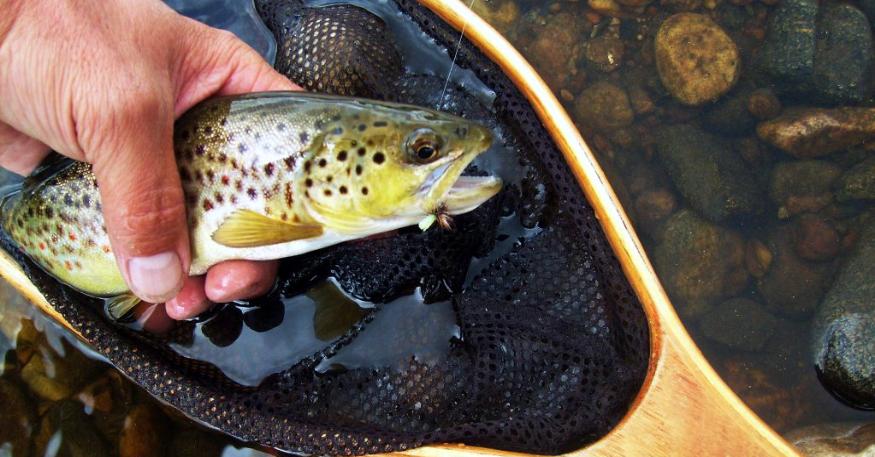
Type of Stream
Freestone/Tailwaters (2)
Species
Rainbow Trout (Wild)
Brown Trout (Wild)
Brook Trout (Wild)
Cutthroat (Native)
Size
Medium
Location
Southwest Wyoming
Nearest Towns
Kemmerer
Season
Year-round except as noted in the
article
Access:
Good
Non-Resident License
State of Wyoming
Weather
National Weather Service Link
Fly and Gear ordering and delivery:
Email us at (sales@perfectflystore.com) with the dates you will be fishing and we will send you a list of our fly recommendations. We can get flies and gear to you within two to three business days from the time you place your order via Priority Mail. If you provide a budget for flies, we will select them to match the budget and get them to you on time for your trip. Your can also call us at 800-594-4726 and we will help you decide what flies and gear to use. All orders are shipped free in the U.S. If under a $100 order requiring Priority mail is a charge of only $8.10. Orders over a $100 are shipped free via Priority Mail.
We have custom Perfect Fly selections in 3 different price ranges for this stream that come with or without fly boxes that make excellent gifts. Click Here To Order or Call us at 800 594 4726 or email us at sales@perfectflystore.com.
The Ham’s Fork River lies in the Southwest section of Wyoming. Even though it flows mostly through desert, it still offers some great fly fishing opportunity. This is mostly because of two tailwater along the way. Discharges from the depths of the two reserviors, stay cool even during warm weather months. It is greatly underrated and under fished. The stream lies near the town of Kemmerer, Wyoming. The river has a population of rainbow, brown, brook and cutthroat trout. The closest large city is Salt Lake, Utah. Most of the anglers fish it are probably from Salt Lake City. It ends by flowing into the Green River at Flaming Gorge.
The first reservoir below the freestone section is, Lake Viva Naughton. It is the largest of the two reservoirs along the river. It’s deep water is also the coolest during hot weather. It doesn’t freeze during the cold winter months.
The freestone section of the river above Lake Viva Naughton is a typical rocky mountain freestone stream. The average size trout is a little smaller than those in the tailwaters but probably average around 12 inches. It is really under fished and can provide some continuous action.
Below the first dam, which many consider the best of the two reservoirs, the stream winds a short distance and drains into the smaller Kemmerer Reservoir. The fish in this section are large averaging about 16 to 18 inches. Fish from Kemmerer Reservoir run up into the tailwater section of Kemmerer Reservoir to spawn.
Below KemmererReservoir, which is a top top release dam, the stream can get two warm during the hottest months. It does provide some opportunity during the spring months. Browns do better in this section than the rainbows. It shouldn’t be avoided by any means. There is a lot of stream access and some big browns there.
Most of the Ham’s Fork flows through private land. You may not find that to be a problem as long as you ask permission from the landowner to fish. Some agree to allow public access points on their land. Upstream of Kemmerer there are many well-signed access points that are easily found. If you go, pleased show respect for the privilege.
Within the section between the reservoirs, there is a public access pullout and an access ladder over the fence just above the point the river flows into Kemmerer Reservoir.
Hatches and Trout Flies:
The Hams Fork has a very diverse population of aquatic insects but they vary from its headwaters to the two tailwaters. The most plentiful mayflies are the Pale Morning Duns, Blue-winged Olives, Green Drakes, Small western Green Drakes, March Browns, and Tricos. There are several others. The most plentiful caddisflies are the Spotted Sedges, Green Sedges, Little Black Caddis, Short-horned Sedges and October Caddis but there are others. Midges are important during the cold weather but especially below the dams. Blood or red midges, Cream and Light Greens are the most plentiful. Stoneflies make up a large part of the trout’s diet in the Hams Fork. Winter Stoneflies, Salmonflies, Golden Stoneflies and Little Yellow Stoneflies are the most plentiful ones. There are lots of terrestrial insects that become important during the summer months of the year. Grass Hoppers, Carpenter Ants, Japanese Beetles and others are among the most plentiful terrestrials.